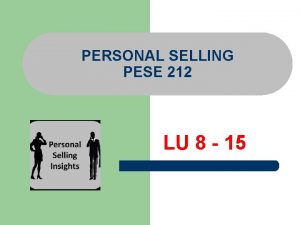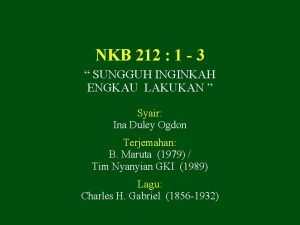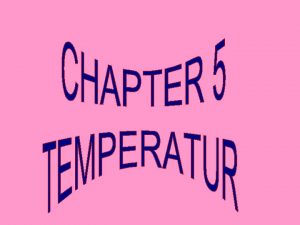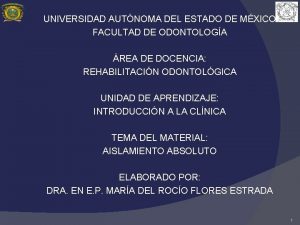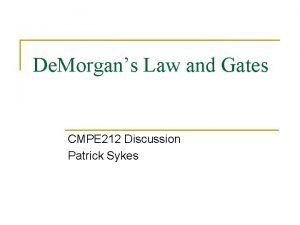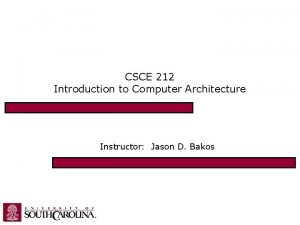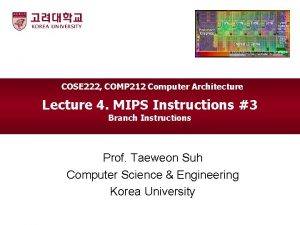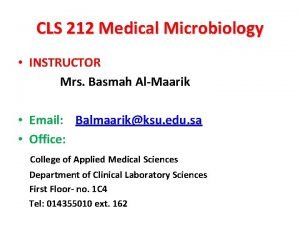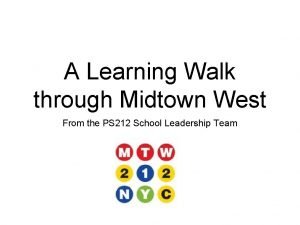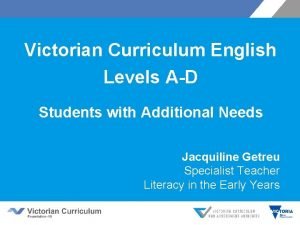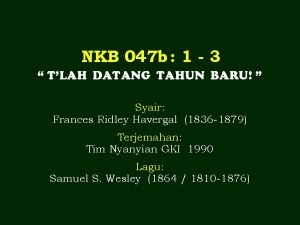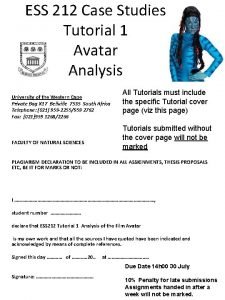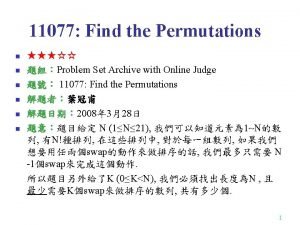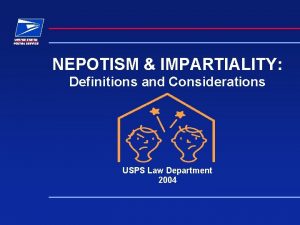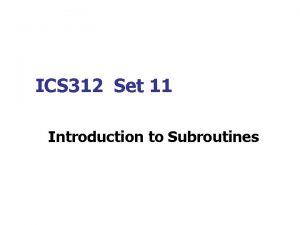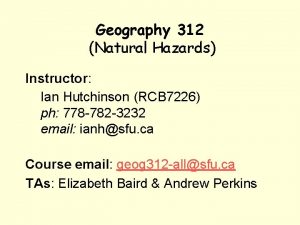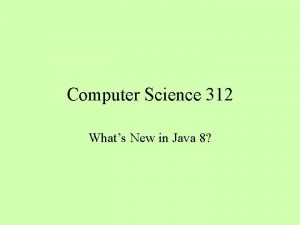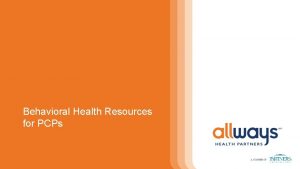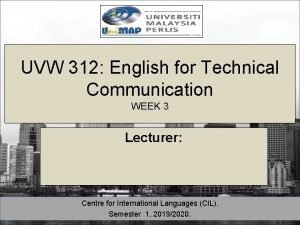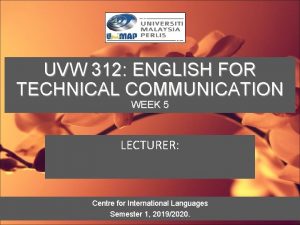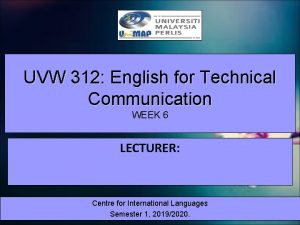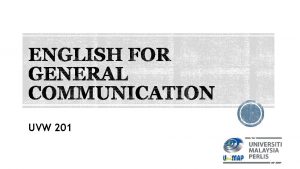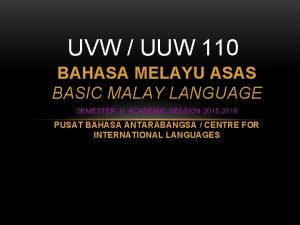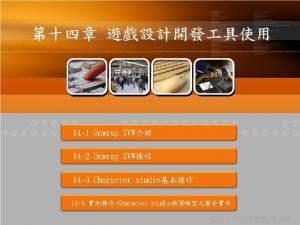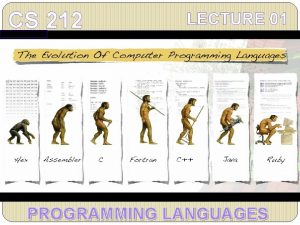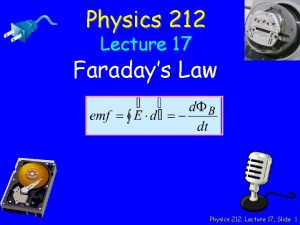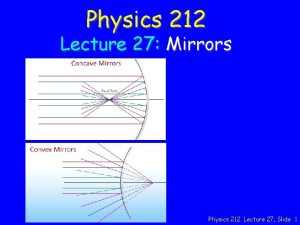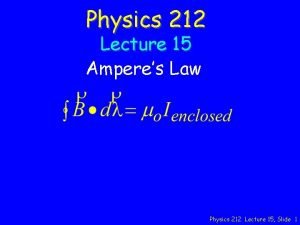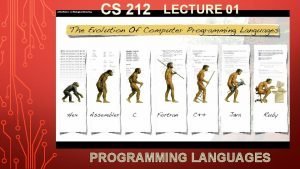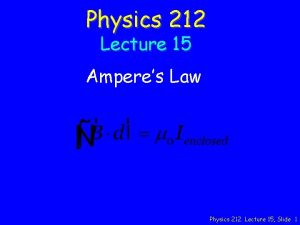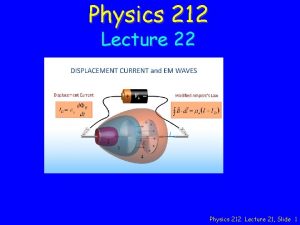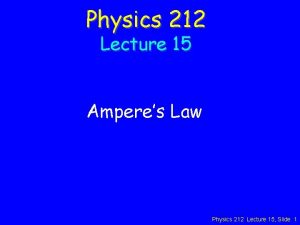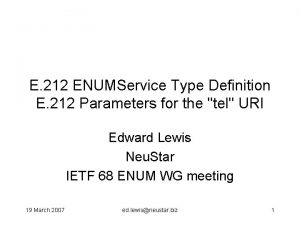UUWEUW 212 UNIVERSITY ENGLISH UVW 312 ENGLISH FOR













































- Slides: 45

UUW/EUW 212: UNIVERSITY ENGLISH UVW 312: ENGLISH FOR TECHNICAL COMMUNICATION LECTURER: WEEK 3 (CHAPTER 3) Center for International Languages (Semester 1 2015/2016)

Now, REWIND & FREEZE, again. Let’s just say…there is this girl/boy that you like in your University English class… HOW would you approach him/ her?


Now, ‘Gathering information’ is very IMPORTANT…isn’t it? The same goes with your report. We have PRIMARY and SECONDARY sources. If you relate back to the analogy of the boymeets-girl or girl-meets-boy, the DIFFERENCE between the two sources is very clear. THINK ABOUT IT ^^ Moving on….

Document-based Research What is a document-based research? Document research is the process of reading through existing documentation relevant to a certain project or area of interest. The writer may support thesis/problem statement using: 1. his/her own experiences, knowledge, and 2. information obtained from other sources.

Types of Information The term research refers to the process of collecting information/data from varied sources for use in the report. The information used can be classified into two major types: 1. Primary Sources 2. Secondary Sources

PRIMARY SOURCES Data (information or ideas) generated/produced by a researcher for the first time using research methods appropriate to a particular field of study. A primary source is a document or physical object which was written or created during the time under study. These sources were present during an experience or time period and offer an inside view of a particular event. Some types of primary sources include: ORIGINAL DOCUMENTS (excerpts or translations acceptable): Diaries, speeches, manuscripts, letters, interviews, news film footage, autobiographies, official records

PRIMARY SOURCES include: Ø Unsolicited inquiries – it is unsolicited if the recipient has done nothing to prompt your inquiry. Ø Informational interviews Ø Surveys Ø Observations or experiments

SECONDARY SOURCES Data (information and ideas) produced by other people using the information gathered from their own primary and/or secondary research. A secondary source interprets and analyzes primary sources. These sources are one or more steps removed from the event. Secondary sources may have pictures, quotes or graphics of primary sources in them. Some types of seconday sources include: PUBLICATIONS: Textbooks, magazine articles, histories, criticisms, commentaries, encyclopedias

SECONDARY SOURCES WEB-BASED SECONDARY TRADITIONAL SECONDARY SOURCES ØGeneral commercial, ØBooks and periodicals organizational and academic ØReference works websites ØBibliographies ØOnline news and magazines ØEncyclopedias ØBlogs ØDictionaries ØInternet forums and discussion ØHandbooks groups ØAbstracts ØE-libraries ØPeriodical databases

Research Methodology Primary Research 1. Research methods for collecting primary information: � � Conducting survey Conducting interview Conducting observation Conducting experiment Secondary Research 2. Secondary research: Research methods for collecting secondary information � � � Consulting printed reference works in the library Searching for information on the WWW Gathering information from databases

Now, REWIND & FREEZE, for the 2 ND TIME. Primary Research Primary Sources Secondary Research Secondary Sources Original documents: Experiments Observations Survey Interview Books Periodical journals Certain websites & electronic databases, etc. SOURCES include in Document-based Research for your EVALUATION REPORT WHY do we need to put these sources into our REPORT?

Asking question QUESTIONNAIRE LECTURER: Center for International Languages (Semester 2 2014/2015)

RESEARCH METHODOLOGY Primary Research Primary methods i. Experiment ii. Observation iii. Interview iv. Survey Secondary Research

SURVEY Ø Survey is a method for gathering primary information from a group of people by asking them a set of predetermined questions. Ø Survey can be conducted: i. Using a self-administered questionnaire ii. In person (Interview) iii. By telephone iv. Via the Internet

SURVEY: QUESTIONNAIRE • The use of self-administered questionnaire to collect information from people. • A questionnaire is basically a written list of questions. • What should you ask? – What information do you want to know? – What are the important aspects underlying the information?

PROBLEMATIC QUESTIONS A. Presuming/ Leading questions. e. g. Don’t you agree that the bank should open at night for the convenience of clients? Questions that use phrases like "Wouldn't you say that…. . " or "Don't you agree that……. . " These phrases may also lead the respondents to prefer a certain choice given.

PROBLEMATIC QUESTIONS B. Questions which rely on memory. E. g. “How many times did you SMS your friend last week? " Questions which tax the respondent's memory too much are likely to lead to non-response or inaccurate replies.

PROBLEMATIC QUESTIONS C. Questions requiring prior knowledge E. g. “Do you think Uni. MAP’s engineering clean room is the best in Malaysia? " D. Long wordy questions Questions that have many words. If the questions are too long and detailed, the respondent may get lost and the responses will relate only to the beginning or the end of the question.

PROBLEMATIC QUESTIONS E. Double-barrelled questions E. g. "Are your lectures and tutorials enjoyable and easy to understand? " Yes / No What is the answer, if • One may find the lectures in a subject easy but the tutorials more difficult, or • One may find both easy to understand but do not enjoy them.

PROBLEMATIC QUESTIONS F. Non-mutually exclusive responses. Multiple choice questions where the choices are not mutually exclusive. This will make a respondent uncertain about which answer he/she should select. G. Sensitive questions. – Personal details (e. g. age); Health; Personal habits; Income; Etc.

PROBLEMATIC QUESTIONS H. Hypothetical questions A hypothetical question asks respondents to indicate what they think they would do under particular imaginary circumstances. Example; If you were given a million dollars, …. They should not be used often although these can't always be avoided in some attitudinal research. They often give rise to unreliable answers.

PROBLEMATIC QUESTIONS: P M K L D N S H PRESUMING questions Questions which rely on MEMORY Questions that need prior KNOWLEDGE LONG wordy questions DOUBLE barrelled questions NON-mutually exclusive responses SENSITIVE questions HYPOTHETICAL questions

How to deal with ‘sensitive questions? People are more likely to give honest replies to personal questions if some rapport has been developed with the interviewer. Therefore, it is generally best to keep all questions dealing with demographic information (such as age) at the end of the questionnaire.

How many questions would be enough? Some considerations: i. Questionnaire that can be answered quite easily. ii. Enough to give you the information needed.

DESIGNING A QUESTIONNAIRE Center for International Languages (Semester 2 2014/2015)

Types of Questions Closed-ended/ Closed Questions Open-ended/ Open Questions Common types: – Dichotomous – Multiple choice – Likert scale – Semantic differential – Rank order – Numeric Common types: – Unstructured – Word association – Sentence completion

Closed-ended Questions A. Dichotomous Description: Question offering two choices e. g. Did you watch television at all yesterday? Yes / No B. Multiple Choice Description: Question offering three or more choices

Closed-ended Questions C. Likert Scale Description: Statement with which respondent shows the amount of agreement / disagreement e. g. Assessment by course-work is easier than assessment by examination. Strongly agree Agree ( ( ) ) Neither agree nor disagree ( ) Disagree ( ) Strongly disagree ( )

Closed-ended Questions D. Semantic Differential Description: Scale is inscribed between two bipolar words and respondent selects the point that most represents the direction and intensity of his / her feelings Example: The engineering degree I am taking is. . Interesting: _____: ___: Boring Useful: _____: _____: Useless Easy : _____: _____: Difficult

Closed-ended Questions E. Rank Order Description: Respondent is asked to rate or rank each option that applies. This allows the researcher to obtain information on relative preferences, importance etc. Long lists should be avoided (respondents generally find it difficult to rank more than 5 items) Example: Please indicate, in rank order, your preferred chocolate brand, putting 1 next to your favourite through to 5 for your least favourite. ____ Beryl ____ Snickers ____ Cadbury ____ Mars Bar ____ Hersey’s

Closed-ended Questions F. Numeric Description: Respondent specifies a particular value (can include decimal places) Example: How far (to the nearest kilometre) did you travel today to reach this supermarket? ____km

Open-ended Questions A. Unstructured Description: Question that respondents can answer in an unlimited number of ways? Example: Why did you choose to study at Uni. MAP? ……………………………………

Open-ended Questions B. Word Association Description: Words are presented one at a time and respondents give the first word that comes to mind Example: What is the first thing that comes to mind when you hear the following: • Lecture: _______ (e. g. Interesting, boring) • Computer: _______ (e. g. Exciting, fun) • Exam: _______ (e. g. Nervous, Challenging) • Tutorial: _______ (e. g. Rewarding, helpful)

Open-ended Questions C. Sentence Completion Description: Incomplete sentences are presented, one at a time, and respondents are asked to complete the sentence Example: While visiting KLCC, I felt ……………….

Closed-ended Questions Advantages i. i. Quick to answer ii. Easy to code iii. No difference between ii. articulate and inarticulate respondents Disadvantages Can draw misleading conclusions because of limited range of options. Researcher / interviewer cannot deal with qualifications to responses e. g. "Yes, but…. . " or "It depends" where only Yes/No are given as options

Open-ended Questions Advantages Disadvantages i. Greater freedom of expression ii. No bias due to limited response range iii. Respondent can qualify their answers i. Time consuming to code information collected ii. Researcher / interviewer may misinterpret (and therefore misclassify) a result

QUESTIONNAIRE: Design Instructions A. General instructions: 1. At the beginning of the questionnaire: Ø Indicate that who you are and why you are doing the survey. You should also have a letter from your lecturer or supervisor to authenticate this. Ø (If applicable) indicate how the respondents were selected Ø Indicate how it is to be answered Ø How to return the questionnaire (if not being delivered in person)

QUESTIONNAIRE: Design Instructions B. Confidentiality/ Anonymity C. Question instructions At the beginning of each part: Ø Ensure that each part (block of similar questions) or each question has a clear instruction on how to respond. Ø Indicate the form of the answer expected (e. g. numeric, tick-box, rank etc. ) and how many answers are expected, by using "most relevant", "one only" or "all which apply"

QUESTIONNAIRE: Design Instructions D. Routing (skip and jump) instructions Where respondents' answers to an earlier question affects subsequent sets of questions, ensure that the route which they should take is clearly specified, for example, "If NO, please go to Question 15“.

Questions’ Order Respondents may refuse to co-operate if your survey begins with awkward or embarrassing questions.

Questionnaire: Layout i. Print clearly ii. Allow adequate space between questions so that you can write down any comments made (but don't waste too much paper!!) iii. Write the questions themselves in lower case (i. e. like this writing) iv. Write the INSTRUCTIONS in UPPER CASE (i. e. capital letters)

Pilot Study A. Purposes: i. To test how long it takes to complete. ii. To check that the questions are not ambiguous. iii. To check that the instructions are clear. iv. To allow you to eliminate questions that do not produce usable data. v. Ideally it should be piloted on a group similar to the one that will form the population of your study.

Questionnaire Checklist • Have you avoided all leading questions? • Is the question as specific as possible? – Avoid using words like "occasionally", "regularly", "often" • Are the questions going to be understood by all respondents? – Avoid the two extremes of vocabulary (a) technical jargon; (b) slang or colloquialisms • Is each question applicable to all respondents? – If not, you will need a "filtering" question first • Are any of your questions double-barrelled?

PRIMARY & SECONDARY sources are all other people’s works…. how about PROPOSAL REPORT? HOW are you going to collect INFORMATION? YOUR
 Eocr 회로도
Eocr 회로도 Eocr 내부결선도
Eocr 내부결선도 Q=vc physics
Q=vc physics Physics 212 gradebook
Physics 212 gradebook Pese 212
Pese 212 Nkb 212 sungguh inginkah engkau lakukan
Nkb 212 sungguh inginkah engkau lakukan Ienf-212
Ienf-212 Et 212
Et 212 Et 212
Et 212 12345 6789 10
12345 6789 10 Archimedes ( arşimet) (mö 287–212 )
Archimedes ( arşimet) (mö 287–212 ) How did archimedes die
How did archimedes die Phys 212 equation sheet
Phys 212 equation sheet 212 instalaciones tecnicas ejemplos
212 instalaciones tecnicas ejemplos Ckdiv
Ckdiv X:3=212
X:3=212 Suhu suatu zat 212 f, maka suhu mutlaknya adalah.... *
Suhu suatu zat 212 f, maka suhu mutlaknya adalah.... * Naca 63-212
Naca 63-212 Partes de las grapas dentales
Partes de las grapas dentales Cls 212
Cls 212 Naca 63-212
Naca 63-212 Cls 212
Cls 212 Cmpe 212
Cmpe 212 212
212 212
212 Cls 212
Cls 212 Ps 212 midtown west
Ps 212 midtown west Vcela 212
Vcela 212 Garra de arquímedes
Garra de arquímedes Classification of pneumonia
Classification of pneumonia Marcos moreira professor
Marcos moreira professor Special purpose diodes
Special purpose diodes Et 212
Et 212 Frequency response curve of an amplifier
Frequency response curve of an amplifier Phy 212
Phy 212 Nkb 204
Nkb 204 Avatar 212
Avatar 212 B 212 neu
B 212 neu Cse 312
Cse 312 123 132 213 231 312 321
123 132 213 231 312 321 Usps law department
Usps law department Ics 312
Ics 312 Cse 312
Cse 312 Natural hazards definition ap human geography
Natural hazards definition ap human geography Java 8 312
Java 8 312 Po box 30512 salt lake city
Po box 30512 salt lake city




